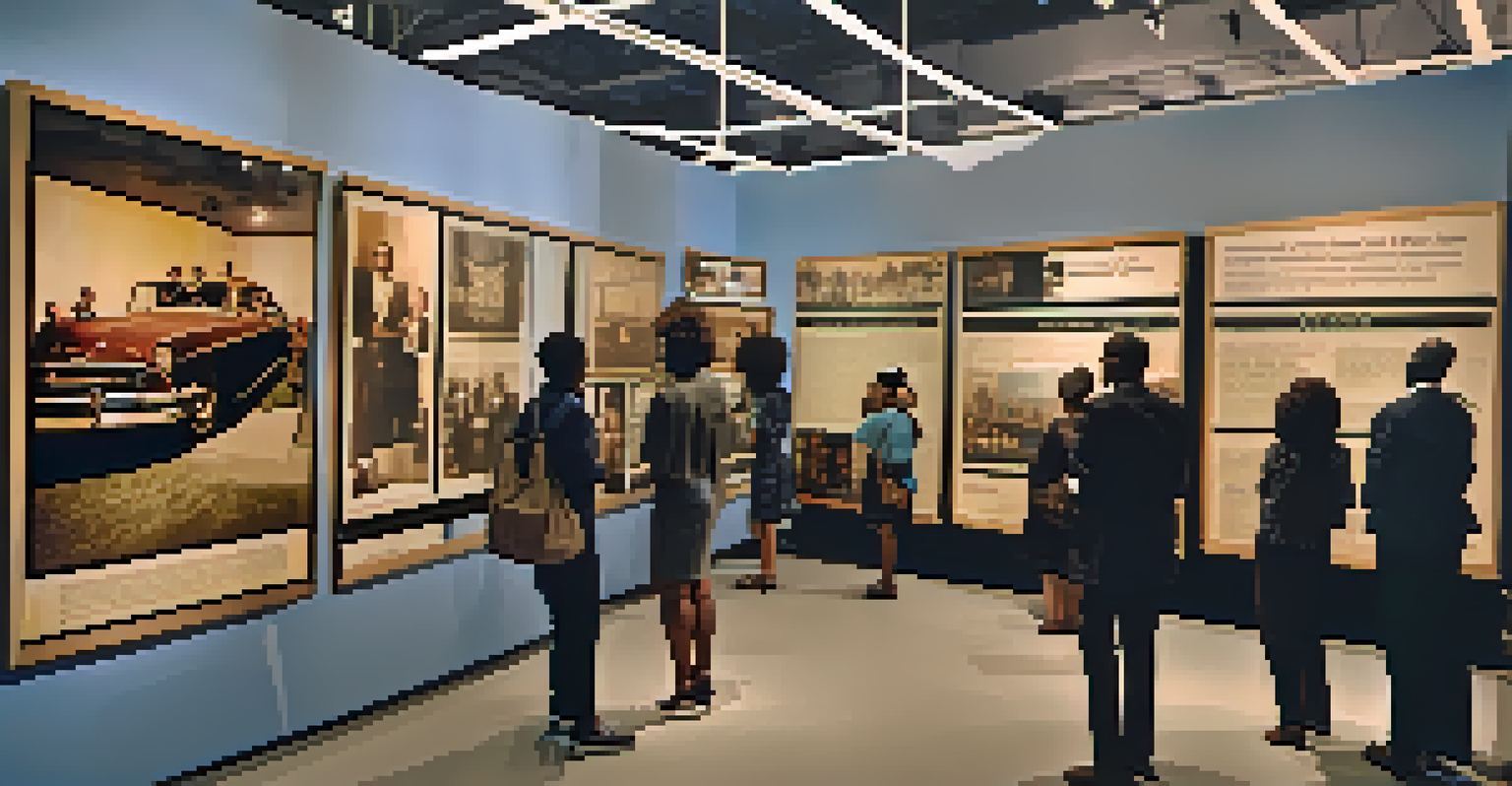The National Civil Rights Museum: A Journey to Justice

Understanding the National Civil Rights Museum's Purpose
The National Civil Rights Museum serves as a vital beacon of hope, focusing on the ongoing struggle for civil rights in America. Located in Memphis, Tennessee, the museum is built around the former Lorraine Motel, where Dr. Martin Luther King Jr. was assassinated in 1968. This location not only provides historical context but also adds a profound emotional weight to the museum's mission.
Injustice anywhere is a threat to justice everywhere.
The museum aims to educate visitors about the history of civil rights in the U.S., highlighting key events, figures, and movements that shaped the fight for equality. Through its exhibits, it encourages reflection and dialogue about the progress made and the work still needed. It’s a reminder that the journey to justice is ongoing and requires participation from everyone.
By visiting the museum, individuals can gain a deeper understanding of systemic racism and social injustice, making it a crucial stop for anyone interested in history and activism. It serves as a powerful reminder of the past while inspiring future generations to continue the fight for equality.
A Walk Through History: Key Exhibits to Explore
As you step into the National Civil Rights Museum, you're greeted by a series of compelling exhibits that chronicle pivotal moments in the civil rights movement. From the early struggles against segregation to the landmark legislation of the 1960s, each exhibit tells a story that resonates deeply. For instance, the exhibit on the Montgomery Bus Boycott vividly illustrates the power of collective action.

One particularly impactful area is the Freedom Rides exhibit, which details the bravery of activists who challenged racial segregation in interstate travel. Visitors can explore the stories of these courageous individuals through multimedia presentations and artifacts, allowing them to connect emotionally with the history. Such immersive experiences make the exhibits memorable and thought-provoking.
Museum as a Civil Rights Beacon
The National Civil Rights Museum educates visitors on the ongoing struggle for equality, emphasizing the importance of understanding history to inspire future activism.
Additionally, the museum showcases the contributions of lesser-known figures alongside famous icons like Rosa Parks and Malcolm X. This approach highlights the diverse coalition of individuals who played vital roles in the movement, emphasizing that change often comes from the grassroots level.
The Lorraine Motel: A Site of Reflection
At the heart of the museum lies the Lorraine Motel, a site of profound significance in American history. This was the location where Dr. Martin Luther King Jr. was assassinated, and it now serves as a poignant reminder of the sacrifices made in the fight for civil rights. The preserved motel rooms offer a glimpse into the past, inviting visitors to reflect on the impact of his legacy.
The time is always right to do what is right.
Standing outside Room 306, where Dr. King spent his last moments, can evoke strong emotions. It’s a solemn experience that encourages visitors to contemplate not just the loss of a leader but the broader implications of violence against those fighting for justice. This moment within the museum serves as a catalyst for discussion about the importance of nonviolence and peace.
The Lorraine Motel’s preservation as part of the museum also underscores the importance of remembering our history. It acts as a call to action, urging visitors to honor Dr. King's message of equality and justice in their own lives.
Engagement Through Interactive Learning
One of the standout features of the National Civil Rights Museum is its commitment to interactive learning. Visitors of all ages can engage with the exhibits through multimedia displays, personal stories, and hands-on activities that make history feel alive. This approach not only enhances understanding but also encourages active participation.
For instance, the museum offers programs that encourage visitors to reflect on their own beliefs and experiences related to social justice. Interactive stations allow guests to explore the significance of various movements and engage with questions that challenge their perspectives. This creates a more personal connection to the material.
Interactive Learning Engagement
The museum's commitment to interactive exhibits and community programs fosters a deeper connection to civil rights issues and encourages active participation.
Furthermore, the museum hosts workshops and events that foster community discussions about contemporary civil rights issues, making it a living institution. By blending history with current events, the museum helps bridge the gap between the past and present, inspiring individuals to become advocates for change.
Programs and Events: Continuing the Conversation
The National Civil Rights Museum goes beyond static exhibits by hosting a variety of programs and events that promote ongoing dialogue about civil rights issues. These initiatives include panel discussions, film screenings, and guest lectures featuring activists, historians, and artists. Such events provide a platform for diverse voices and perspectives.
Engaging with the community is a core mission of the museum, and it frequently collaborates with local organizations to address contemporary challenges. For example, workshops on topics like voting rights and social justice empower participants to take action in their own communities. This involvement creates a dynamic atmosphere that reinforces the museum’s relevance.
Additionally, annual events such as the Martin Luther King Jr. Day celebrations attract large crowds, fostering a sense of unity and purpose. These gatherings not only honor Dr. King’s legacy but also inspire a new generation to continue the fight for equality and justice.
Visitor Experience: Making the Most of Your Trip
Planning a visit to the National Civil Rights Museum can be an enriching experience, but it's essential to approach it with intention. To fully appreciate the depth of the exhibits, consider allocating ample time to explore each section. The museum offers guided tours, which can provide additional context and insights from knowledgeable staff.
As you navigate through the museum, take advantage of the audio guides and informational plaques that enhance your understanding of the exhibits. Engaging with the material thoughtfully can deepen your connection to the stories and events presented. Don’t rush through; instead, allow yourself to reflect on the significance of what you’re learning.
Legacy of Dr. King Reflected
The preservation of the Lorraine Motel serves as a poignant reminder of Dr. Martin Luther King Jr.'s sacrifices, urging visitors to reflect on their role in the struggle for justice.
Finally, be sure to visit the museum’s gift shop, which features books, art, and educational materials related to civil rights. This can be a great way to continue your journey of understanding beyond your visit, as well as support the museum's mission.
Conclusion: The Importance of Remembering and Acting
The National Civil Rights Museum serves as a powerful reminder of the ongoing struggle for justice and equality in America. By exploring its exhibits and participating in its programs, visitors gain a deeper understanding of the sacrifices made by those who fought for civil rights. This knowledge empowers individuals to act in the present, ensuring that the lessons of the past are not forgotten.
As you leave the museum, consider how you can apply what you've learned to your own life. Whether it’s through advocacy, education, or simply having conversations about civil rights, every action counts. The journey toward justice involves collective effort, and each of us has a role to play.

Ultimately, the National Civil Rights Museum is not just a place to learn about history; it's a call to honor the legacy of those who came before us by continuing their fight for equality. By embracing this mission, we can work together to create a more just and equitable society for everyone.